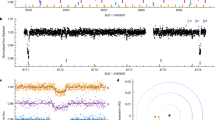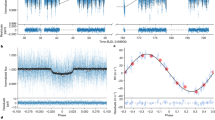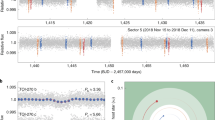Abstract
One aim of modern astronomy is to detect temperate, Earth-like exoplanets that are well suited for atmospheric characterization. Recently, three Earth-sized planets were detected that transit (that is, pass in front of) a star with a mass just eight per cent that of the Sun, located 12 parsecs away1. The transiting configuration of these planets, combined with the Jupiter-like size of their host star—named TRAPPIST-1—makes possible in-depth studies of their atmospheric properties with present-day and future astronomical facilities1,2,3. Here we report the results of a photometric monitoring campaign of that star from the ground and space. Our observations reveal that at least seven planets with sizes and masses similar to those of Earth revolve around TRAPPIST-1. The six inner planets form a near-resonant chain, such that their orbital periods (1.51, 2.42, 4.04, 6.06, 9.1 and 12.35 days) are near-ratios of small integers. This architecture suggests that the planets formed farther from the star and migrated inwards4,5. Moreover, the seven planets have equilibrium temperatures low enough to make possible the presence of liquid water on their surfaces6,7,8.
This is a preview of subscription content, access via your institution
Access options
Access Nature and 54 other Nature Portfolio journals
Get Nature+, our best-value online-access subscription
$29.99 / 30 days
cancel any time
Subscribe to this journal
Receive 51 print issues and online access
$199.00 per year
only $3.90 per issue
Buy this article
- Purchase on Springer Link
- Instant access to full article PDF
Prices may be subject to local taxes which are calculated during checkout


Similar content being viewed by others
References
Gillon, M. et al. Temperate Earth-sized planets transiting a nearby ultracool dwarf star. Nature 533, 221–224 (2016)
de Wit, J. et al. A combined transmission spectrum of the Earth-sized exoplanets TRAPPIST-1 b and c. Nature 537, 69–72 (2016)
Barstow, J. K. & Irwin, P. G. J. Habitable worlds with JWST: transit spectroscopy of the TRAPPIST-1 system? Mon. Not. R. Astron. Soc. 461, L92–L96 (2016)
Cresswell, P. & Nelson, R. P. On the evolution of multiple protoplanets embedded in a protostellar disc. Astron. Astrophys. 450, 833–853 (2006)
Mills, S. M. et al. A resonant chain of four transiting, sub-Neptune planets. Nature 533, 509–512 (2016)
Kopparapu, R. K. et al. Habitable zones around main-sequence stars: new estimates. Astrophys. J. 765, 131 (2013)
Leconte, J. et al. 3D climate modelling of close-in land planets: circulation patterns, climate moist instability, and habitability. Astron. Astrophys. 554, A69 (2013)
Stevenson, D. J. Life-sustaining planets in interstellar space? Nature 400, 32 (1999)
Gillon, M. et al. The TRAPPIST survey of southern transiting planets. I. Thirty eclipses of the ultra-short period planet WASP-43 b. Astron. Astrophys. 542, A4 (2012)
Agol, E., Steffen, J., Sari, R. & Clarkson, W. On detecting terrestrial planets with timing of giant planet transits. Mon. Not. R. Astron. Soc. 359, 567–579 (2005)
Holman, M. J. & Murray, N. W. The use of transit timing to detect terrestrial-mass extrasolar planets. Science 307, 1288–1291 (2005)
Fabrycky, D. C. in Exoplanets (ed. Seager, S. ) 217–238 (Univ. Arizona Press, 2010)
Winn, J. N. in Exoplanets (ed. Seager, S. ) 55–77 (Univ. Arizona Press, 2010)
Zeng, L., Sasselov, D. D. & Jacobsen, S. B. Mass-radius relation for rocky planets based on PREM. Astrophys. J. 819, 127 (2016)
Chiang, E. & Laughlin, G. The minimum-mass extrasolar nebula: in situ formation of close-in super-Earths. Mon. Not. R. Astron. Soc. 431, 3444–3455 (2013)
Kane, S. R., Hinkel, N. R. & Raymond, S. N. Solar system moons as analogs for compact exoplanetary systems. Astron. J. 146, 122 (2013)
MacDonald, M. G. et al. A dynamical analysis of the Kepler-80 system of five transiting planets. Astron. J. 152, 105 (2016)
Papaloizou, J. C. B. & Szuszkiewicz, E. On the migration-induced resonances in a system of two planets with masses in the Earth mass range. Mon. Not. R. Astron. Soc. 363, 153–176 (2005)
Terquem, C. & Papaloizou, J. C. B. Migration and the formation of systems of hot super-Earths and Neptunes. Astrophys. J. 654, 1110–1120 (2007)
Goldreich, P. & Tremaine, S. Disk-satellite interactions. Astrophys. J. 241, 425–441 (1980)
Raymond, S. N., Barnes, R. & Mandell, A. M. Observable consequences of planet formation models in systems with close-in terrestrial planets. Mon. Not. R. Astron. Soc. 384, 663–674 (2008)
Alibert, Y. & Benz, W. Formation and composition of planets around very low mass stars. Astron. Astrophys. 598, L5 (2017)
Kasting, J. F., Whitmire, D. P. & Reynolds, R. T. Habitable zones around main-sequence stars. Icarus 101, 108–128 (1993)
Ribas, I. et al. The habitability of Proxima Centauri b. I. Irradiation, rotation and volatile inventory from formation to the present. Astron. Astrophys. 596, A111 (2016)
Wordsworth, R. D. et al. Is Gliese 581d habitable? Some constraints from radiative-convective climate modeling. Astron. Astrophys. 522, A22 (2010)
Turbet, M. et al. The habitability of Proxima Centauri b II. Possible climates and observability. Astron. Astrophys. 596, A112 (2016)
Kopparapu, R. K. et al. The inner edge of the habitable zone for synchronously rotating planets around low-mass stars using general circulation models. Astrophys. J. 819, 84 (2016)
Bolmont, E. et al. Water loss from Earth-sized planets in the habitable zones of ultracool dwarfs: implications for the planets of TRAPPIST-1. Mon. Not. R. Astron. Soc. 464, 3728–3741 (2017)
Barnes, R. et al. Tidal limits to planetary habitability. Astrophys. J. 700, L30–L33 (2009)
Luger, R. & Barnes, R. Extreme water loss and abiotic O2 buildup on planets throughout the habitable zone of M dwarfs. Astrobiol. 15, 119–143 (2015)
Gillon, M. et al. TRAPPIST: a robotic telescope dedicated to the study of planetary systems. EPJ Web Conf. 11, 06002 (2011)
Jehin, E. et al. TRAPPIST: TRAnsiting Planets and PlanetesImals Small Telescope. Messenger 145, 2–6 (2011)
Pirard, J.-F. et al. HAWK-I: a new wide-field 1- to 2.5 μm imager for the VLT. Proc. SPIE 5492, 1763–1772 (2004)
Casali, M. et al. The UKIRT IR Wide-Field Camera (WFCAM). In The New Era of Wide-Field Astronomy (eds Clowes, R., Adamson, A. & Bromage, G. ) 357–363 (ASPC Conf. Series Vol. 232, 2001)
Benn, C., Dee, K. & Agócs, T. ACAM: a new imager/spectrograph for the William Herschel Telescope. Proc. SPIE 7014, 70146X (2008)
Stetson, P. B. DAOPHOT—a computer program for crowded-field stellar photometry. Publ. Astron. Soc. Pacif. 99, 191–222 (1987)
Fazio, G. G. et al. The Infrared Array Camera (IRAC) for the Spitzer Space Telescope. Astrophys. J. Suppl. Ser. 154, 10–17 (2004)
Ingalls, J. G. et al. Intra-pixel gain variations and high-precision photometry with the Infrared Array Camera (IRAC). Proc. SPIE 8442, http://dx.doi.org/10.1117/12.926947 (2012)
Knutson, H. A. et al. The 3.6–8.0 μm broadband emission spectrum of HD 209458b: evidence for an atmospheric temperature inversion. Astrophys. J. 673, 526–531 (2008)
Gillon, M. et al. Search for a habitable terrestrial planet transiting the nearby red dwarf GJ 1214. Astron. Astrophys. 563, A21 (2014)
Eastman, J., Siverd, R. & Gaudi, B. S. Achieving better than 1 minute accuracy in the heliocentric and barycentric Julian dates. Publ. Astron. Soc. Pacif. 122, 935–946 (2010)
Mandel, K. & Agol, E. Analytic light curves for planetary transit searches. Astrophys. J. 580, L171–L175 (2002)
Schwarz, G. E. Estimating the dimension of a model. Ann. Stat. 6, 461–464 (1978)
Filippazzo, J. C. et al. Fundamental parameters and spectral energy distributions of young and field age objects with masses spanning the stellar to planetary regime. Astrophys. J. 810, 158 (2015)
Claret, A. A new non-linear limb-darkening law for LTE stellar atmosphere models. Calculations for −5.0 ≤ log[M/H] ≤ +1, 2000K ≤ Teff ≤ 50000K at several surface gravities. Astron. Astrophys. 363, 1081–1190 (2000)
Claret, A. & Bloemen, S. Gravity and limb-darkening coefficients for the Kepler, CoRoT, Spitzer, uvby, UBVRIJHK, and Sloan photometric systems. Astron. Astrophys. 529, A75 (2011)
Gelman, A. & Rubin., D. B. Inference from iterative simulation using multiple sequences. Stat. Sci. 7, 457–472 (1992)
Deck, K. M. et al. TTVFast: an efficient and accurate code for transit timing inversion problems. Astrophys. J. 787, 132 (2014)
Chambers, J. E. A hybrid symplectic integrator that permits close encounters between massive bodies. Mon. Not. R. Astron. Soc. 304, 793–799 (1999)
Agol, E. & Deck, K. M. Transit timing to first order in eccentricity. Astrophys. J. 818, 177 (2016)
Deck, K. M. & Agol, E. Transit timing variations for planets near eccentricity-type mean motion resonances. Astrophys. J. 821, 96 (2016)
Levenberg, K. A method for certain problems in least squares. Q. Appl. Math. 2, 164–168 (1944)
Nelder, J. A. & Mead, R. A simplex method for function minimization. Comput. J. 7, 308–313 (1965)
Hanno, R. & Tamayo, D. WHFast: a fast and unbiased implementation of a symplectic Wisdom-Holman integrator for long-term gravitational simulations. Mon. Not. R. Astron. Soc. 452, 376–388 (2015)
Pu, B. & Wu, Y. Spacing of Kepler planets: sculpting by dynamical instability. Astrophys. J. 807, 44 (2015); erratum 819, 170 (2016)
Bolmont, E. et al. Formation, tidal evolution, and habitability of the Kepler-186 system. Astrophys. J. 793, 3 (2014)
Bolmont, E. et al. Mercury-T: a new code to study tidally evolving multi-planet systems. Applications to Kepler-62. Astron. Astrophys. 583, A116 (2015)
Deck, K. M., Payne, M. & Holman, M. J. First-order resonance overlap and the stability of close two-planet systems. Astrophys. J. 774, 129 (2013)
Acknowledgements
This work is based in part on observations made with the Spitzer Space Telescope, which is operated by the Jet Propulsion Laboratory, California Institute of Technology, under a contract with NASA. The material presented here is based on work supported in part by NASA under contract no. NNX15AI75G. TRAPPIST-South is a project funded by the Belgian Fonds (National) de la Recherche Scientifique (F.R.S.-FNRS) under grant FRFC 2.5.594.09.F, with the participation of the Swiss National Science Foundation (FNS/SNSF). TRAPPIST-North is a project funded by the University of Liège, and performed in collaboration with Cadi Ayyad University of Marrakesh. The research leading to these results has received funding from the European Research Council (ERC) under the FP/2007-2013 ERC grant agreement no. 336480, and under the H2020 ERC grant agreement no. 679030; and from an Actions de Recherche Concertée (ARC) grant, financed by the Wallonia–Brussels Federation. The VLT data used in this work were taken under program 296.C-5010(A). UKIRT is supported by NASA and operated under an agreement among the University of Hawaii, the University of Arizona, and Lockheed Martin Advanced Technology Center; operations are enabled through the cooperation of the East Asian Observatory. The Liverpool Telescope is operated on the island of La Palma by Liverpool John Moores University (JMU) in the Spanish Observatorio del Roque de los Muchachos of the Instituto de Astrofisica de Canarias, with financial support from the UK Science and Technology Facilities Council. This paper uses observations made at the South African Astronomical Observatory (SAAO). M.G., E.J. and V.V.G. are F.R.S.-FNRS research associates. B.-O.D. acknowledges support from the Swiss National Science Foundation in the form of a SNSF Professorship (PP00P2_163967). E.A. acknowledges support from National Science Foundation (NSF) grant AST-1615315, and NASA grants NNX13AF62G and NNH05ZDA001C. E.B. acknowledges that this work is part of the F.R.S.-FNRS ExtraOrDynHa research project and acknowledges funding by the European Research Council through ERC grant SPIRE 647383. S.N.R. thanks the Agence Nationale pour la Recherche (ANR) for support via grant ANR-13-BS05-0003-002 (project MOJO). D.L.H. acknowledges financial support from the UK Science and Technology Facilities Council. The authors thank C. Owen, C. Wolf and the rest of the SkyMapper team for their attempts to monitor the star from Australia; from UKIRT, the director R. Green and the staff scientists W. Varricatt and T. Kerr; the ESO staff at Paranal for their support with the HAWK-I observations; JMU and their flexibility as regards the Liverpool Telescope schedule, which allowed us to search actively for the planets, and to extend our time allocation in the face of amazing results; for the William Herschel Telescope, C. Fariña, F. Riddick, F. Jímenez and O. Vaduvescu for their help and kindness during observations; and for SAAO, the telescopes operations manager R. Sefako for his support.
Author information
Authors and Affiliations
Contributions
M.G. leads the ultracool dwarf transit survey that uses the TRAPPIST telescope and led the photometric follow-up of the star TRAPPIST-1; he also planned and analysed most of the observations, led their scientific exploitation, and wrote most of the manuscript. A.H.M.J.T. led the observational campaign using the La Palma telescopes (the Liverpool Telescope, LT, and William Herschel Telescope, WHT). C.M.C. managed the scheduling of the LT observations, and Ar.B. performed the photometric analysis of the resulting LT and WHT images. B.-O.D. led the TTV/dynamical simulations. E.A. and K.M.D. performed independent analyses of the transit timings. J.G.I. and S.J.C. helped to optimize the Spitzer observations. B.-O.D., J.G.I. and J.d.W. performed independent analyses of the Spitzer data. M.G., E.J., L.D., Ar.B., P.M., K.B., Y.A. and Z.B. performed the TRAPPIST observations and their analysis. S.M.L. obtained the director’s discretionary time on UKIRT, and, with E.J., managed the preparation of the UKIRT observations. M.T., J.L., F.S., E.B. and S.N.R. carried out atmospheric modelling for the planets and worked on the theoretical interpretation of their properties. V.V.G. managed the SAAO observations performed by C.S.F., M.R.B., D.L.H., A.C. and E.J.K. All co-authors assisted with writing the manuscript. A.H.M.J.T. prepared most of the figures.
Corresponding author
Ethics declarations
Competing interests
The authors declare no competing financial interests.
Additional information
Reviewer Information Nature thanks D. Deming and I. Snellen for their contribution to the peer review of this work.
Extended data figures and tables
Extended Data Figure 1 Light curve of a triple transit of planets c, e and f.
The black points show the differential photometric measurements extracted from VLT/HAWK-I images taken on 11 December 2015, with the formal 1σ errors shown as vertical lines. The best-fit triple-transit model is shown as a red line. Possible configurations of the planets relative to the stellar disc are shown below the light curve for three different times (red, planet c; yellow, planet e; green, planet f). The relative positions and sizes of the planets, as well as the impact parameters, correspond to the values in Table 1.
Extended Data Figure 2 Transit light curve for planets d and e.
The black points show the photometric measurements, binned per 0.005 days (7.2 min). The error for each bin (shown as a vertical line) was computed as the 1σ error on the average. These light curves are divided by their best-fit instrumental models and by the best-fit transit models of other planets (for multiple transits). The best-fit transit models are shown as solid lines. The light curves are period-folded on the best-fit transit ephemeris given in Table 1, their relative shifts on the x-axis reflecting TTVs due to planet–planet interactions (see text). The epoch of the transit and the facility used to observe it are indicated above each light curve.
Extended Data Figure 3 Transit light curves for planets f and g.
As for Extended Data Fig. 2, but for planets f and g.
Extended Data Figure 4 TTVs measured for planets b, c, d, e, f and g.
For each planet, the best-fit TTV model computed with the n-body numerical integration code Mercury52 is shown as a red line. The 1 σ errors of the transit timing measurements are shown as vertical lines.
PowerPoint slides
Rights and permissions
About this article
Cite this article
Gillon, M., Triaud, A., Demory, BO. et al. Seven temperate terrestrial planets around the nearby ultracool dwarf star TRAPPIST-1. Nature 542, 456–460 (2017). https://doi.org/10.1038/nature21360
Received:
Accepted:
Published:
Issue Date:
DOI: https://doi.org/10.1038/nature21360
This article is cited by
-
Search for distant atmosphere off to a rocky start
Nature (2023)
-
No thick carbon dioxide atmosphere on the rocky exoplanet TRAPPIST-1 c
Nature (2023)
-
Atmospheric carbon depletion as a tracer of water oceans and biomass on temperate terrestrial exoplanets
Nature Astronomy (2023)
-
Analogous response of temperate terrestrial exoplanets and Earth’s climate dynamics to greenhouse gas supplement
Scientific Reports (2023)
-
Interstellar photovoltaics
Scientific Reports (2023)
Comments
By submitting a comment you agree to abide by our Terms and Community Guidelines. If you find something abusive or that does not comply with our terms or guidelines please flag it as inappropriate.



